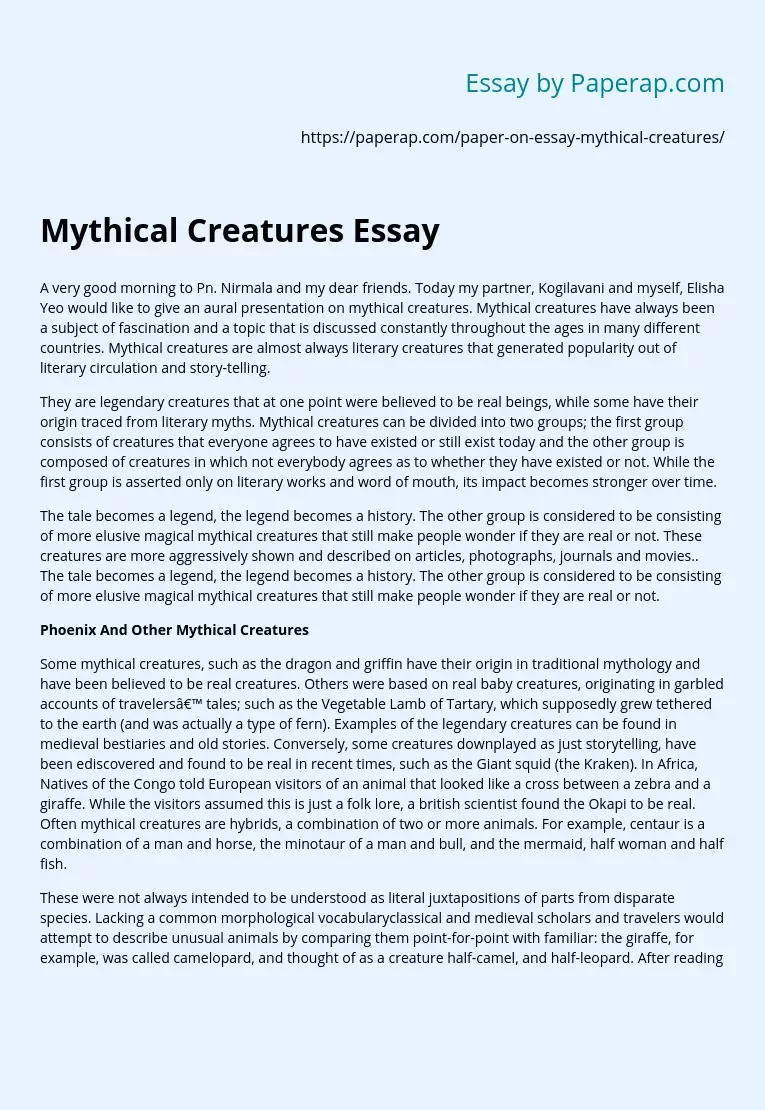Mythical Creatures Essay
A very good morning to Pn. Nirmala and my dear friends. Today my partner, Kogilavani and myself, Elisha Yeo would like to give an aural presentation on mythical creatures. Mythical creatures have always been a subject of fascination and a topic that is discussed constantly throughout the ages in many different countries. Mythical creatures are almost always literary creatures that generated popularity out of literary circulation and story-telling.
They are legendary creatures that at one point were believed to be real beings, while some have their origin traced from literary myths.
Mythical creatures can be divided into two groups; the first group consists of creatures that everyone agrees to have existed or still exist today and the other group is composed of creatures in which not everybody agrees as to whether they have existed or not. While the first group is asserted only on literary works and word of mouth, its impact becomes stronger over time.
The tale becomes a legend, the legend becomes a history.
The other group is considered to be consisting of more elusive magical mythical creatures that still make people wonder if they are real or not. These creatures are more aggressively shown and described on articles, photographs, journals and movies.. The tale becomes a legend, the legend becomes a history. The other group is considered to be consisting of more elusive magical mythical creatures that still make people wonder if they are real or not.
Phoenix And Other Mythical Creatures
Some mythical creatures, such as the dragon and griffin have their origin in traditional mythology and have been believed to be real creatures.
Others were based on real baby creatures, originating in garbled accounts of travelers’ tales; such as the Vegetable Lamb of Tartary, which supposedly grew tethered to the earth (and was actually a type of fern). Examples of the legendary creatures can be found in medieval bestiaries and old stories. Conversely, some creatures downplayed as just storytelling, have been ediscovered and found to be real in recent times, such as the Giant squid (the Kraken). In Africa, Natives of the Congo told European visitors of an animal that looked like a cross between a zebra and a giraffe. While the visitors assumed this is just a folk lore, a british scientist found the Okapi to be real. Often mythical creatures are hybrids, a combination of two or more animals. For example, centaur is a combination of a man and horse, the minotaur of a man and bull, and the mermaid, half woman and half fish.
These were not always intended to be understood as literal juxtapositions of parts from disparate species. Lacking a common morphological vocabularyclassical and medieval scholars and travelers would attempt to describe unusual animals by comparing them point-for-point with familiar: the giraffe, for example, was called camelopard, and thought of as a creature half-camel, and half-leopard. After reading through the list of mythical creatures I found the phoenix to be a very interesting creature.
The Phoenix has long been presented as a symbol of rebirth, immortality, and renewal. The phoenix originated in ancient mythology and has gone through a variety of representations in art/literature, ranging from being fully birdlike to having the head of a dog and suckling its young. Typically, it is considered benevolent, but some tales suggest that humans are not always safe around it. Further, many tales share elements with those of the phoenix.
Originally, the phoenix was identified by the Egyptians as a strork or heron-like bird called a benu, known from theBook of the Dead and other Egyptian texts as one of the sacred symbols of worship at Heliopolis, closely associated with the rising sun and the Egyptian sun-God Ra. The Greeks subsequently pictured the bird more like a peacock or an eagle and identified it with their own word phoenix (? ), meaning the color purple-red or crimson (cf. Phoenicia) or a palm tree. According to the Greek mythology the phoenix lived in Phoenicia next to a well.
At dawn, it bathed in the water of the well, and the Greek sun-god Helios stopped his chariot in order to listen to its song. Herodotus spoke about the unique capabity of the bird to be consumed in the flames and be reborn from the ashes. In China, the Fenghuang is a mythical bird superficially similar to the phoenix. It is the second most-respected legendary creature (second to the dragon), largely used to represent the empress and females, and as such as the counterpart to the Chinese Dragon, traditionally seen as masculine or imperial.
The phoenix is considered the greatest and the leader of birds. In Russian folklore, the phoenix was called the firebird. The phoenix was featured in the flags of Alexander Ypsilantis and of many other captains during the Greek Revolution, symbolizing Greece’s rebirth. In addition, the first modern Greek currency bore the name of phoenix. Despite being replaced by a royal Coat of Arms, it remained a popular symbol. What do you think Kogilavani? Which mythical creature did you like best after going through the list of mythical creatures. I on the other hand find the dragon most interesting.
Dragons arelegendary creatures, typically with serpentine or otherwise reptilian traits, that feature in the myths of many cultures. There are two distinct cultural traditions of dragons: theEuropean Dragon, derived from European folk traditions and ultimately related to Greek and Middle Eastern mythologies, and the Chinese Dragon, with counterparts in Japan, Korea and other Asian countries. The two traditions may have evolved separately, but have influenced each to a certain extent, particularly with the cross-cultural contact of recent centuries. The English word”dragon
Mythical Creatures Essay. (2019, Dec 05). Retrieved from https://paperap.com/paper-on-essay-mythical-creatures/

